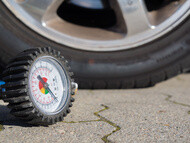
Tips & Advice for Car, SUV & Van tyres
Why is van tyre pressure important? How do you know which pressure is right for your vehicle? How often should you adjust it? And how? If some of these questions are on your mind, then you've come to the right place! Our experts have the answers.
Why is van tyre pressure important?
Over time, a tyre naturally loses pressure, no matter how airtight the valve. This is why it is necessary to adjust the pressure regularly for all tyres, including the spare wheel when it exists. This check also helps to detect any abnormal loss of pressure in one tyre compared to others.
What are the risks of an incorrect van tyre pressure?
A tyre operating at insufficient pressure will see its temperature rise abnormally, which can degrade its internal components. This degradation is irreversible and can lead to the destruction of the tyre by a sudden flattening.
The consequences of driving with insufficient pressure are memorised by the tyre, and may become apparent long afterwards, even after the pressure has been readjusted.
Under-inflation means higher fuel consumption and also increases the risk of loss of grip through hydroplaning.
Whether over-inflated or under-inflated, a tyre will wear quickly and sometimes unevenly, usually resulting in the need for premature replacement.
Correct pressure:
- Safety
- Longevity
- Optimal fuel consumption
-0.5 Bar:
- Reduced tyre life
-1 Bar:
- Risk of tyre blow-out
- Increased fuel consumption
- Altered road handling
- Increased braking distance
How often should you check your van tyre pressure?
You can check your pressure about once a month. It is also important to do this before every long journey.
How to adjust your van tyre pressure?
Measured in BAR or PSI, tyre pressure can be adjusted at a service station air pump or with a manual compressor, preferably when the tyres are cold, i.e. when the vehicle has been driven little or not at all.
When you unplug the valve cap and insert the pump mouthpiece, the pump's gauge shows the current pressure of your van tyre. Buttons allow you to add or remove air to achieve the correct van tyre pressure.
Note that if the check is carried out after driving, the tyre may have warmed up: it should never be deflated in this case, as the pressure increases with the temperature.

Van tyre pressure can be adjusted at a service station air pump
What pressure should I inflate my van tyres to?
Michelin recommends to follow and respect the tyre pressure recommended by the vehicle manufacturer.
It can be usually found inside the van's door on the driver's side. Sometimes it is also in the fuel filler flap.
You can also refer to our online tool to find the recommended pressure for your type of van.
It should be noted that there are several recommended pressures for the same vehicle, depending on whether it is lightly or heavily loaded. Due to the nature of commercial vans, which often involve loading and unloading goods, the weight fluctuates significantly and therefore requires the van tyre pressure to be adjusted accordingly.
If you overload your van without adjusting the tyre pressure, the tyres will wear out much faster and will have to be changed prematurely. We therefore advise you to ensure that your van tyre pressure is correct for its load before setting off.
The specificity of the “C" marking on tyres
Light commercial vehicle tyres have a "C" marking that means the carcass has been reinforced to be able to withstand higher loads than a conventional vehicle (see our article on reinforced tyres).
On the sidewall of a tyre with a “C” marking, two load index are indicated: the first for a single mounting (two tyres on the rear axle), the second for a dual mounting (four tyres mounted on the rear axle for a better load distribution).
In order for these reinforced tyres to be able to withstand heavier loads than a passenger car, it is also necessary to inflate them to a higher pressure, as recommended by the vehicle manufacturer.

Find the right pressure for your van
In our tool below, you can enter the make, model and other details of your vehicle to find out the pressure recommended by your manufacturer.
How to use our tyre pressure tool?
Here is an example: if you want to know the Renault Master van tyre pressure, select "Renault" in the "Make" box, then "Master" and the model in the "model" box, then the year, the engine size and the tyre size.
After validating your choices, the next page informs you of the pressure for the front tyres and the pressure for the rear tyres, presented in bars, in the "View size details" section. You can change the data you have entered at any time.
Find the right tyre
Enter your Reg, vehicle or tyre size
We're searching for your tire...
Wait few seconds we're processing your photo
MICHELIN Agilis CrossClimate
Van
The MICHELIN Agilis CrossClimate tyre: what your business demands.
View this tyre
Buy now
MICHELIN Agilis 3
Van
Take care of your business and do your bit for the environment.
View this tyre
Buy now
MICHELIN Agilis Alpin
Van
MICHELIN Agilis Alpin: Don't let harsh winters stop your business.
View this tyre
Buy now
AGILIS RANGE
View more


